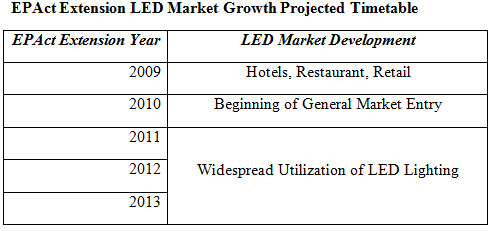The Economic, Business and Tax Aspects of Light Emitting Diode Interior Building Lighting
Commercial building facilities managers, financial executives and tax departments are beginning to encounter the first stages of the inevitable widespread introduction of Light Emitting Diode (LED) lighting for building interiors. These intriguing semiconductor devices produce powerful amounts of energy efficient light with a much longer life cycle then current generation lighting products. Despite current high purchase costs for certain first mover applications, this method of lighting can result in substantially lower operating costs. To consumers, the most familiar direct analogy to the fast changing LED market is the replacement of incandescent bulbs by compact fluorescent (CFC's). When CFC's were first introduced, prices were very high and despite the much longer life cycle, consumer acceptance was slow. Today, the benefits of CFC's are widely accepted and have assumed the most prominent position on home improvement and hardware store shelves.
Some History
Most of us are now familiar with a wide range of special purpose LED applications including traffic lights, exit signs, automobile tail lights and stage lighting. Now LED lighting is quickly mainstreaming into building interior applications.
The Tax Opportunity
On October 3rd, 2008 the President signed the Economic Stabilization Act of 2008 extending the Section 179(D) 60 cent per square foot commercial building EPAct energy efficient lighting tax deduction for 5 years through December 31st, 2013. This was perfect timing for the interior building LED market. Interior LED products are being actively marketed for particular building categories with the expectation that they will be ready for mainstream building applications sometime time in 2010.

Economics
Despite much higher initial cost of purchase, LEDs use less energy and most importantly, they have a much longer life cycle. On average, LEDs use as little as one tenth the electricity of today’s incandescent bulbs and last 40 times longer. A much longer life cycle can save tremendous maintenance costs particularly in areas with high ceilings including theaters, catering halls, sports facilities etc., where aerial equipment is needed for lamp replacements. In other applications, such as when hospitals replace lamps, the process is often very disruptive and is an activity where avoidance is often worth the additional investment cost. LEDs generally uses less energy and accordingly may be eligible for high utility rebates offsetting a meaningful portion of the purchase price. For new buildings, LEDs may reduce the costs of load bearing ceilings and lighting related electrical circuit breaker and light panel infrastructure costs. Unlike compact fluorescent bulbs, LEDs do not have mercury in them or require special handling and disposal. William McShane, the head of sustainable lighting for Crescent Stonco, says "Facilities managers are increasingly interested in lighting business solutions that meet their design goals and also come as an integrated package with quantified energy savings, utility rebates, EPAct tax savings and carbon emission reduction."
Current Building Market Focus
With LEDs lighting, designers can take advantage of better color rendering targeting the spectrum. Accordingly, first movers include generally higher end and distinctive restaurants, hotels, and entertainment facilities. Ralph Vetsch, the manager of Strategic Sales for Philip’s lighting, says "The facilities market place is very interested in the advantages of LED lighting and our products meet both design and energy cost reduction objectives." Parking garages are also becoming popular LED applications. Jason Vogel, Chief Operating Officer of SeeSmart LED, says “Interest in LED lights is especially strong in long use applications, like parking lots, because the return on investment is so quick.”
University studies are indicating that LED lighting may be more conducive to assisted living residents, nursing home residents and hospital patients who can't reach lighting controls or get startled and disoriented when wakening to the sudden glare of current light technology.
The Lighting Research Center (LRC) at Rensselear Polytechnic Institute is the leading University based research center devoted to lighting. On January 12, 2005 the LRC announced the results of an experimental study at the Schuyler Ridge Residential center, a 120 resident skilled Residential nursing facility in Clifton Park, New York. The LRC team installed energy efficient LEDs to determine whether an energy efficient solution could "improve the comfort and care of seniors, assist the nursing staff in their nightly rounds, and help residents navigate hallways." The LRC team concluded that "an automated, non disturbing lighting scheme could be designed to help patients get in and out of bed at night, as well as give nurses enough light for their rounds. Hallways could be distinguished through the uses of colored lighting, which theoretically would serve as navigation guide for residents and visitors.”
LED Issues
As with any new technologies, there are some issues with LED lighting. Generally, this type of lighting is not dimmable without special technology. This was actually the same issue when fluorescent lighting first came out. LEDs generate a lot of heat which makes thermal insulation heat protection important. Another issue is called binning in the LED industry. All LEDs are unique so there is need to batch or bin the most similar LEDs in order to maintain a uniformity of light. The analogy here is to eggs: where you expect the eggs in your carton to be uniform in size and color.
Conclusion
Facilities, financial and tax executives need to team together to evaluate LED building interior projects. The high initial cost may not be the determining factor once all pros and cons are considered particularly for specific market applications.